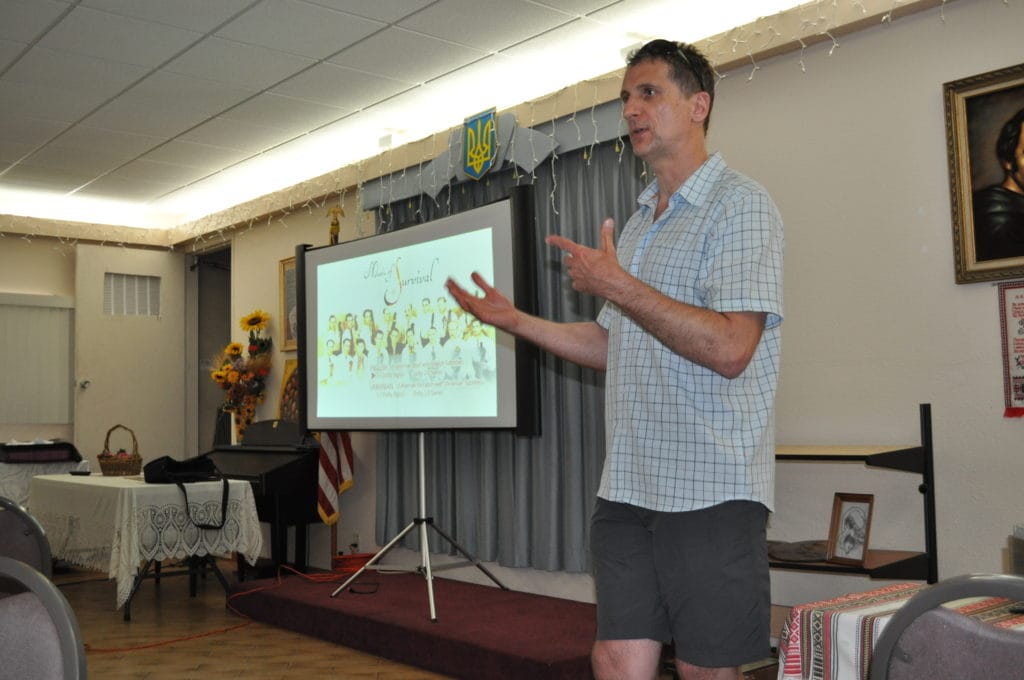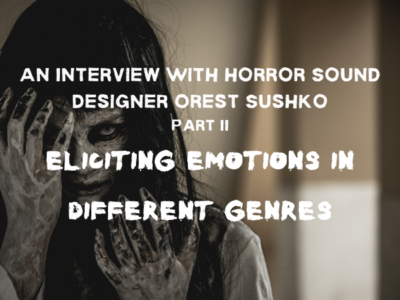Orest Sushko is an Emmy-nominated sound designer. Katja Rogers interviewed him during her PhD.
Orest Sushko – Biography
As a re-recording mixer, Orest’s work in shaping the soundtracks for film and television has garnered him two Emmy nominations, an Emmy award, twelve Gemini nominations, three Genie nominations, a Genie award, two CSA nominations, and a CAS (Cinema Audio Society) Award. He is also the recipient of an International Monitor Award, numerous MPSE accreditations, and a Golden Sheaf Award. Orest has had the distinct pleasure of mixing seven films for acclaimed director David Cronenberg including Crash, Spider, A History of Violence, Eastern Promises, A Dangerous Method, Cosmopolis, and Maps to The Stars. With numerous years mixing feature films in Hollywood, his work has been influenced by a broad range of directors and producers including Barry Sonnenfeld, Judd Apatow, and Guillermo Del Toro. He has also mixed soundtracks for television series including Orphan Black, the Netflix series Frontier and documentaries from David Suzuki, to The North Face, The Patagonia and Alan Doyle of Great Big Sea.
Orest has also produced and directed the documentary film Music of Survival narrated by Colm Feore. When time permits, Orest serves as faculty at various colleges in southern Ontario (including Humber, Sheridan and Niagara college) where he teaches sound post-production in film media studies. He holds a Masters in Media Production from Ryerson University. Orest was recently accepted as a Fulbright Specialist and will be lecturing on sound post-production at various Universities in Eastern Europe while presenting his film to new audiences.

Orest Sushko got in touch with Professor Nacke of the HCI Games Group early this year. This was particularly exciting for me as I spent last summer at the HCI Games Group as an international researcher investigating audio in (VR) games. A lot of research on the effect of audio in games has focused on the horror genre (e.g., Lin 2017, Lynch & Martins 2015, Vachiratamporn et al. 2015), as anxiety and fear are strong emotions that are easier to elicit and measure than many other emotions conveyed through narratives. With Orest’s extensive background in not only audio design but also audio design in horror movies (through his work with David Cronenberg, a principal filmmaker in the body horror/visceral horror genre), this was particularly fascinating.
I was ecstatic to have the chance to skype with Orest and pick his mind about inducing emotions through the audio in horror movies and his thoughts on using these techniques in games. As a sound designer and re-recording mixer, his job is to turn bits and pieces of sound into a complete soundtrack in a way that is “dramatically effective and convincing.”
KR: In the many steps of audio design for movies, what is your main focus?
OS: Integrating, balancing and coalescing the various disparate elements including dialogue, sound effects, and music into a final cohesive sound mix. By disparate, I’m referring to elements delivered to me in a manner where sounds are recorded in different environments, with varying degrees of noise, and often with a different aesthetic (i.e. production dialogue may differ from one scene recording to another, from one set-up to another, and even one take to another). Sound effects may be recorded in another environment (possibly requiring equalization, noise reduction, or artificial reverberation to help “set them in” to a specific scene of the narrative.
Katja Rogers, Giovanni Ribeiro, Rina R. Wehbe, Michael Weber, and Lennart E. Nacke. 2018. Vanishing Importance: Studying Immersive Effects of Game Audio Perception on Player Experiences in Virtual Reality. In Proceedings of the 2018 CHI Conference on Human Factors in Computing Systems (CHI'18). Association for Computing Machinery, New York, NY, USA, Paper 328, 1–13.
One of the studies I conducted at Waterloo over the summer involved an interview after participants had played a commercial VR horror adventure game. One of the things that were mentioned a lot is the need for audio types to be appropriate, and suiting the overall atmosphere. In many cases, audio shouldn’t be too noticeable. And indeed, in many cases, as we reported in our paper on the study (Rogers et al. 2018), participants did not even notice that background music had been present at all. This reflects the challenge in conducting audio research: as our results show, the influence of audio is subtle, particularly so in VR, and highly subjective. Instinctively, participants pointed out the importance of what is essentially Orest’s job:
OS: The most fulfilling projects for me have always been the ones where I don’t hear my own work or contribution to the film. That sounds odd, but I seek complete transparency in my efforts. The narrative should just flow seamlessly – picture and sound together, without taking us out of the story or the experience through the artifice of sound treatment. […] The end result heard in the final soundtrack comes about through the process of effacement. In other words, you do all this work to make it sound like you did no work at all!
Further, these audio types don’t just have to be set together; movies are a multimodal medium. Audio has to fit into an overall soundscape, but it also has to work with the visual material:
OS: Music elements (especially in the case of a diegetic “source” piece of music that is meant to play within the frame of the action) may require specific treatment (sound processing) to adapt to the visual representation. Thus, sonic grammar needs to work harmoniously with the specific visual grammar provided in the images. The process is a very collaborative one, bringing together the intent of the sound design team, the composer, collectively with the intentions and vision of the director.
Through his role in creating this soundscape, Orest generally works in collaboration with the director (“My role is to serve as the conduit for a director’s vision and execute the needed steps towards realizing that vision.”). As mentioned in his bio, Orest has worked with Cronenberg a lot over the years:
OS: In working with David Cronenberg on his last seven films, I have found the most rewarding of challenges in this regard. David has such a master hand in creating the most effective sonic shapes for his films. In each, we have worked diligently with the entire sound team to sculpt a detailed shape by using only the most necessary of elements in the soundscape. No sound is gratuitous. Everything you hear in his films serves a specific purpose in his storytelling and is well choreographed for maximum impact and intent. It’s not to say that everything is quiet in his movies, rather that they deliver a very specific function for the viewer. In many instances, one moment you are drawn into the silence, the next you are jumping out of your seat with surprise.
In the next part of this blog series, we will be looking into Orest’s views on how to elicit emotions in different movie genres, and in the final part of this blog series, discuss differences of movies and games in terms of audio design.




